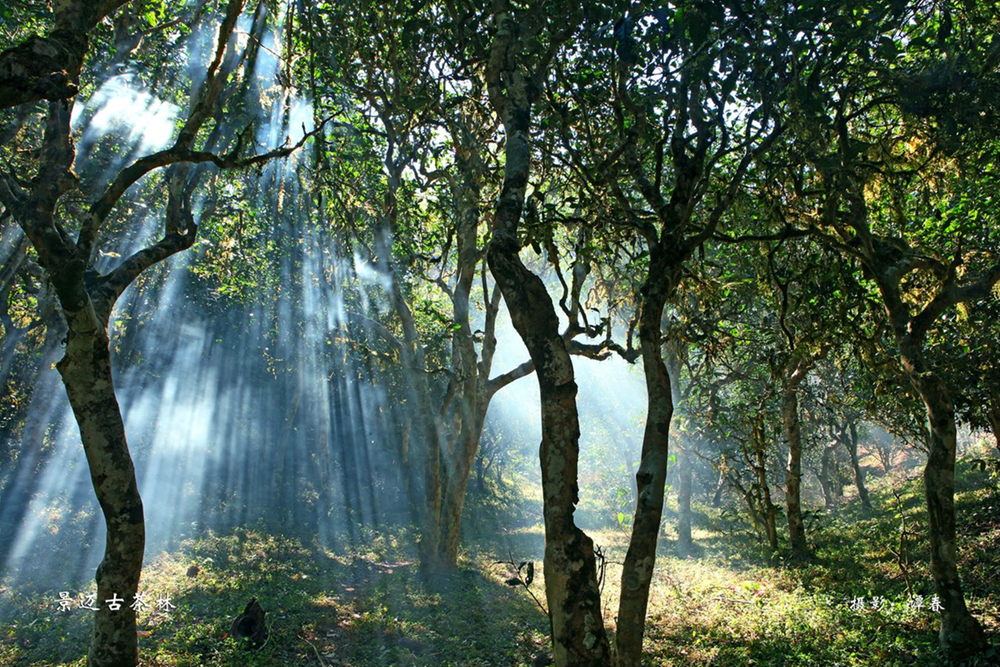Tea fragrance floats through Jingmai Mountain

An old tea forest on Jingmai Mountain. [Photo by Tan Chun/For China Daily]
The Cultural Landscape of Old Tea Forests of the Jingmai Mountain in Pu'er is located in Lancang Lahu autonomous county, Pu'er city, southwest China's Yunnan province.
Since the 10th century, the Bulang and Dai ethnic groups migrated to the Jingmai Mountain, where they discovered and cultivated wild tea trees. Utilizing the forest ecosystem, they developed the under-forest tea planting technology, gradually planting an ancient tea forest of 18,000 mu (1,200 hectares)
Over the centuries, people in this region have rationally used the mountainous land, creating a unique cultural landscape of harmonious coexistence between people and the ancient tea forest.
In September, the Cultural Landscape of Old Tea Forests of the Jingmai Mountain in Pu'er gained World Heritage Site status on the 45th Session of the World Heritage Committee of UNESCO in Riyadh, Saudi Arabia, becoming China's 57th entry on that list. It is also the first World Heritage Site with the theme of tea. Numerous visitors come to explore the beauty of this new site.
Tea and life are inseparable
There are three harvesting periods in Jingmai Mountain: spring, summer, and autumn. Spring tea is harvested from February to April in the lunar calendar, while autumn tea is harvested from August to September. "The tea trees are gaining nutrients in summer, so summer tea is usually not harvested," said the tea farmer Xian Gong.
During this autumn, villagers had a bountiful harvest. According to Xian, villagers here have been planting tea for generations. Some ancient tea trees reach several meters in height, requiring ladders for picking.
During the tea-picking season, busy figures of Bulang and Dai villagers in traditional costumes can be seen everywhere in the ancient tea forest. They move agilely, carefully picking leaves to avoid damaging the ancient tea trees.
Deep within the tea forest are ancient villages. Su Guowen, an 80-year-old resident of Mangjing village on Jingmai Mountain, lives in an ecologically beautiful area surrounded by greenery.
Jingmai Mountain residents have established a unique village layout to effectively manage the relationship between people and the forest, and the tea forest: the water source is at the mountaintop, ancient tea forests and villages are in the middle of the mountain, protective forests surround the periphery to prevent pest spread, and arable land is in the lower-altitude valley with ample water to avoid damaging the ancient tea forest during cultivation.
"Tea is inseparable from our lives," Su said. Every year, as long as his health permits, he would harvest and process tea with his family. The traditional culture of living in harmony with nature and the coexistence of people and tea has long been integrated into various aspects of villagers' lives. It could be seen from the tea leaves packaged in bamboo tubes, wooden shoulder bags, and decorations on village rooftops in the pattern of "one bud, two leaves" of ancient tea trees.
Tea tourism enhances villagers' income
A local proverb says, "Money and treasure will eventually be used up; cattle and livestock will eventually die. Only tea gardens and tea trees remain to support the lives of future generations." Over the years, the local government and residents have agreed on the rational use of the forest, the protection of the tea forest, and the preservation of village culture.
Villagers spontaneously adopted measures such as "no use of chemical fertilizers and pesticides" and "prohibition of destructive harvesting" and incorporated them into village rules and agreements. Furthermore, the local government has enacted over 20 laws and regulations to protect ancient tea trees.
To protect the natural landscape in Jingmai Mountain, keep a man-nature harmony, and preserve the original appearance of villages, the local government prioritized power supply in the tea forest, upgraded residential areas, and improved road conditions for villagers.
Today, walking in Jingmai Mountain, you can still see the luxuriant branches of ancient tea trees and the traditional appearance of villages, with basic infrastructure such as electricity and communication available.
In recent years, the local government has assisted tea farmers in establishing or joining tea-specialized farmers' cooperatives to revitalize the ancient tea forest of Jingmai Mountain.
Tea sales have been promoted through e-commerce platforms, and many villagers post photos of their tea-picking and tea-making processes on social media, attracting people to buy tea and visit. Xian built a farmhouse in Jingmai Mountain, welcoming many tea merchants and tourists.
As the cultural landscape of old tea forests of Jingmai Mountain has been inscribed on the UNESCO, this once-hidden treasure is gaining increasing worldwide attention.
According to statistics, Lancang Lahu autonomous county received 234,000 tourists during this year's Mid-Autumn Festival and National Day holiday, generating 210 million yuan in tourism revenue.
Source: People's Daily; trans-editing by Guo Yao








